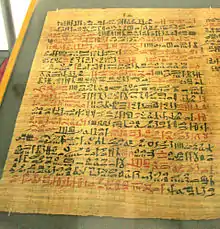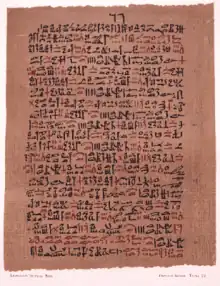Ebers Papyrus
The Ebers Papyrus, also known as Papyrus Ebers, is an Egyptian medical papyrus of herbal knowledge dating to c. 1550 BCE (the late Second Intermediate Period or early New Kingdom). Among the oldest and most important medical papyri of Ancient Egypt, it was purchased at Luxor in the winter of 1873–1874 by the German Egyptologist Georg Ebers. It is currently kept at the Leipzig University Library in Germany.

Manuscript
The papyrus was written in Ancient Egypt in c. 1550 BCE, during the late Second Intermediate Period or early New Kingdom, but it is believed to have been copied from earlier Egyptian texts. The Ebers Papyrus is a 110-page scroll, which is about 20 meters long.[1]
Along with the Kahun Gynaecological Papyrus (c. 1800 BCE), the Edwin Smith Papyrus (c. 1600 BCE), the Hearst papyrus (c. 1600 BCE), the Brugsch Papyrus (c. 1300 BCE), and the London Medical Papyrus (c. 1300 BCE), the Ebers Papyrus is among the oldest preserved medical documents. The Brugsch and the London Medical papyri share some of the same information as the Ebers Papyrus.[2]
Another document, the Carlsberg papyrus, is identical to the Ebers Papyrus, though the provenance of the former is unknown.[2]
Medical knowledge
The Ebers Papyrus is written in hieratic Egyptian writing and represents the most extensive and best-preserved record of ancient Egyptian medicine known.[3]
The scroll contains some 700 magical formulas and folk remedies.[4] It contains many incantations meant to turn away disease-causing demons and there is also evidence of a long tradition of empiricism.[5]
The papyrus contains a "treatise on the heart". It notes that the heart is the centre of the blood supply, with vessels attached for every member of the body.
The ancient Egyptians seem to have known little about the kidneys and made the heart the meeting point of a number of vessels which carried all the fluids of the body—blood, tears, urine and semen.
Mental disorders are detailed in a chapter of the papyrus called the Book of Hearts. Disorders such as depression and dementia are covered. The descriptions of these disorders suggest that Egyptians conceived of mental and physical diseases in much the same way.
The papyrus contains chapters on contraception, diagnosis of pregnancy and other gynecological matters, intestinal disease and parasites, eye and skin problems,[6] dentistry, the surgical treatment of abscesses and tumors, bone-setting, and burns.
The "channel theory" was prevalent at the time of writing of the Ebers papyrus; it suggested that unimpeded flow of bodily fluids is a prerequisite for good health.
The Ebers papyrus may be considered a precursor of ancient Greek humeral pathology and the subsequently established theory of humorism, providing a historical connection between ancient Egypt, ancient Greece, and medieval medicine.[6]
Examples of medical remedies
Examples of remedies in the Ebers Papyrus include:
- Birth control: "To prevent conception, smear a paste of dates, acacia, and honey to wool and apply as a pessary."[7]
- Diabetes mellitus: "Drink a mixture including elderberry, asit plant fibres, milk, beer-swill, cucumber flowers, and green dates." It is not known what "asit" is.[8]
- Guinea-worm disease: "Wrap the emerging end of the worm around a stick and slowly pull it out." 3,500 years later, this remains the standard treatment.[9]
Medicinal use of ochre clays
One of the more common remedies described in the papyrus is ochre, or medicinal clay. It is prescribed for intestinal and eye complaints. Yellow ochre is also described as a remedy for urological complaints.[10]
Insect repellents
The use of insect repellents derived from plants and other organisms found in nature is known from the time of the Ebers Papyrus. Several examples of such repellents can be found in the text.[11]
Calendar
In the time of Amenhotep I a calendar table was written on the verso side of the papyrus.[12] Since 1906 we have a transcript by Kurt Sethe. Some rate this table to be "the most valuable chronological tool from Egypt that we are ever likely to possess". (Tetley 2014)
Modern history of the papyrus
Like the Edwin Smith Papyrus, the Ebers Papyrus came into the possession of Edwin Smith in 1862.
The source of the papyrus is unknown, but it was said to have been found between the legs of a mummy in the El-Assasif district of the Theban necropolis.
The papyrus remained in the collection of Edwin Smith until at least 1869, when there appeared—in the catalog of an antiquities dealer—an advertisement for "a large medical papyrus in the possession of Edwin Smith, an American farmer of Luxor."[13]
The papyrus was purchased in 1872 by the German Egyptologist and novelist, Georg Ebers, after whom it is named.
Translations
In 1875, Ebers published a facsimile with an English-Latin vocabulary and introduction. It was not until 1890, however, that it was translated by H. Joachim. In the early 1900s, Dr. Carl H. von Klein, alongside his daughter Edith Zitelmann, created a direct-to-English translation of the Ebers Papyrus.[14] Ebers retired from his chair of Egyptology at Leipzig on a pension and the papyrus remained in the University of Leipzig library. An English translation of the papyrus was published by Paul Ghalioungui. The papyrus was published and translated by different researchers.
References
- Stern, Ludwig Christian (1875). Ebers, Georg (ed.). Papyros Ebers: Das hermetische Buch über die Arzeneimittel der alten Ägypter in hieratischer Schrift, herausgegeben mit Inhaltsangabe und Einleitung versehen von Georg Ebers, mit Hieroglyphisch-Lateinischem Glossar von Ludwig Stern, mit Unterstützung des Königlich Sächsischen Cultusministerium (in German). Vol. 2 (1 ed.). Leipzig: W. Englemann. LCCN 25012078. Retrieved 2010-09-18.
- Baker, Jill (2018-08-30). Technology of the Ancient Near East: From the Neolithic to the Early Roman Period. Routledge. ISBN 9781351188098.
- Guerini, Vincenzo (1909). A History of Dentistry from the Most Ancient Times Until the End of the Eighteenth Century. Lea & Febiger. p. 19.
- Rogers, Kara (2011-01-15). Medicine and Healers Through History. The Rosen Publishing Group, Inc. ISBN 9781615303670.
- Magner, Lois N. (1992-03-17). A History of Medicine. CRC Press. ISBN 9780824786731.
- PubMed
- "A Brief History of Birth Control: From early contraception to the birth of the Pill". Time. New York. May 3, 2010.
- Roberts, Jacob (2015). "Sickening sweet". Distillations. 1 (4): 12–15. Retrieved 20 March 2018.
- Palmer, Philip E.S.; Reeder, Maurice M. (2008) [First published 1981]. "Chapter 27: Guinea Worm Infection (Dracunculiasis)". The Imaging of Tropical Diseases: With Epidemiological, Pathological and Clinical Correlation (DVD ed.). Uniformed Services University of the Health Sciences. LCCN 99039417.
- The Papyrus Ebers: The Greatest Egyptian Medical Document. Translated by Ebbell, Bendix. Copenhagen: Levin & Munksgaard. 1937. LCCN 37020036. Archived from the original on 2005-02-26.
- Pennacchio, Marcello (2010). Uses & Abuses of Plant-Derived Smoke: Its Ethnobotany as Hallucinogen, Perfume, Incense & Medicine. Oxford University Press. p. 21.
- M. Christine Tetley: The Reconstructed Chronology of the Egyptian Kings. Onerahi 2014, S. 86 f.
- (Breasted 1930)
- Hartsock, Jane; Halverson, Colin (2023-10-02). "Lost in translation: the history of the Ebers Papyrus and Dr. Carl H. von Klein". Journal of the Medical Library Association. 111 (4): 844–851. doi:10.5195/jmla.2023.1755. ISSN 1558-9439.
Further reading
- Ebers (1875). Papyros Ebers: Das Hermetische Buch über die Arzneimittel der alten Ägypter in hieratischer Schrift (Bands 1 & 2): Einleitung und Text. Leipzig: Verlag von Wilhelm Engelmann.
- Papyros Ebers: Das Hermetische Buch über die Arzneimittel der alten Ägypter in hieratischer Schrift. Leipzig: J.C. Hinrich'sche Buchhandlung. 1913.
- Joachim, H. (1890). Papyros Ebers: Das älteste Buch über Heilkunde. Berlin: Druck und Verlag von George Reimer.
- Pommerening, Tanja (2005). "Altägyptische Hohlmaße Metrologisch neu Interpretiert". Die altägyptischen Hohlmaße. studien zur Altägyptischen Kultur Beiheft 10 (in German). Hamburg: Helmut Buske Verlag. ISBN 978-3-87548-411-3.
- Pommerening, Tanja (2005). "relevant pharmaceutical and medical knowledge, an abstract, Phillips-Universitat, Marburg, 8-11-2004". Die altägyptischen Hohlmaße. studien zur Altägyptischen Kultur Beiheft 10 (in German). Hamburg: Helmut Buske Verlag. ISBN 978-3-87548-411-3.
- Scholl, Reinhold (2002). Der Papyrus Ebers. Die größte Buchrolle zur Heilkunde Altägyptens. Schriften aus der Universitätsbibliothek 7 (in German). Leipzig: Universitätsbibliothek Leipzig. ISBN 978-3-910108-93-6. LCCN 2002505846.
- Ghalioungui, Paul; The Ebers Papyrus: A New English Translation, Commentaries and Glossaries by Paul Ghalioungui; 1987 edition.
External links
- The Papyrus Ebers: The Greatest Egyptian Medical Document. Translated by Ebbell, Bendix. Copenhagen: Levin & Munksgaard. 1937. LCCN 37020036. Archived from the original on 2009-03-12.
- Ebers, Georg (1889). Papyrus Ebers: Die Maasse und das Kapitel über die Augenkrankheiten (in German). Leipzig: Bei S. Hirzel.
- The Papyrus Ebers, Translated from the German Version By Cyril P. Bryan (PDF). Translated by Bryan, Cyril P. London: Geoffrey Bles. 1930. Archived from the original (PDF) on 2013-09-21.
